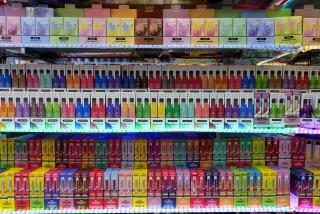FDA cracks down on tobacco marketing to youths
Reporting from Washington — Taking aim at the tobacco industry’s youth marketing machinery, the Food and Drug Administration on Thursday outlawed free samples of cigarettes and banned the use of tobacco brand names on promotional gear and in the sponsorship of concerts and sporting events.
The agency also added a federal ban on the sale of cigarettes and smokeless tobacco products to people under 18, imposing a uniform standard on varying state restrictions already in place.
Under the new rules, store clerks will be required to check photo IDs to verify that customers are old enough to buy tobacco goods.
Other restrictions announced Thursday include bans on the sale of cigarettes via vending machines, except in locations closed to people under 18, and on the sale of packs with fewer than 20 cigarettes. Smaller packs can be cheaper and thus potentially more attractive to young buyers.
The new rules “will help our kids stay healthier by making it harder for tobacco companies to target them,” said Health and Human Services Secretary Kathleen Sebelius at a news conference.
Sebelius said that each day nearly 4,000 people under 18 try smoking for the first time and 1,000 of them become daily smokers.
The new regulations result from power Congress granted the FDA last year to regulate tobacco. The regulations take effect June 22.
The FDA already has used its new authority to ban candy- and fruit-flavored cigarettes and to begin collecting detailed information on the ingredients in all tobacco products.
The new limits were anticipated and “are largely already in place here at R.J. Reynolds,” said David Howard, spokesman for R.J. Reynolds Tobacco Co., maker of Camel, Kool, Winston and other cigarette brands.
Vince Willmore, a spokesman for the nonprofit Campaign for Tobacco-Free Kids, predicted that tobacco firms would try to challenge the restrictions, but said, “We think they are narrowly tailored and supported by science.”
On the advertising front, the FDA has ordered that audio ads refrain from using music or sound effects. Video ads and ads in teen-oriented print publications must be in black and white only.
The latter requirement appears to conflict with a January federal court ruling that tobacco firms could use color in their ads. Aspects of the case have been appealed by tobacco firms and the government.
FDA Commissioner Margaret Hamburg acknowledged the possibility of legal challenges, but said the agency was committed to pressing ahead with tobacco regulation.
More to Read
Sign up for Essential California
The most important California stories and recommendations in your inbox every morning.
You may occasionally receive promotional content from the Los Angeles Times.










